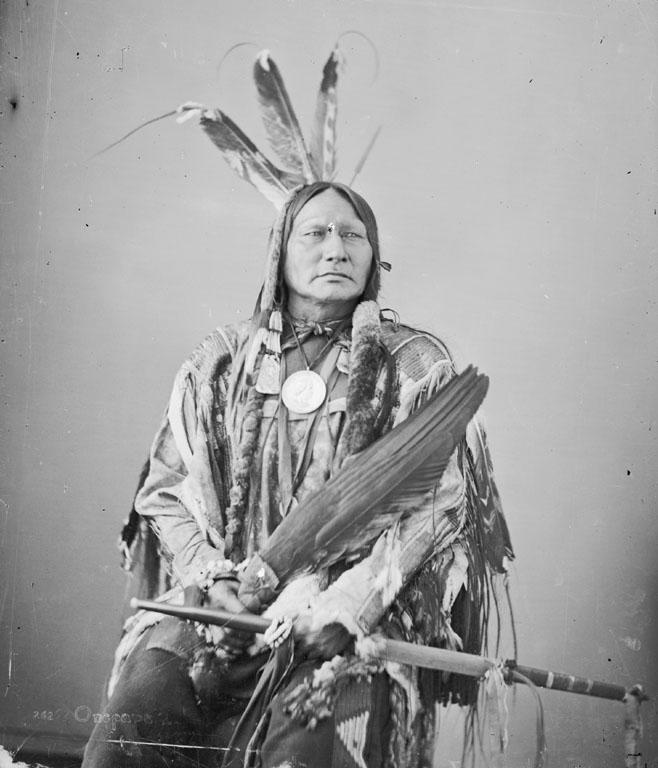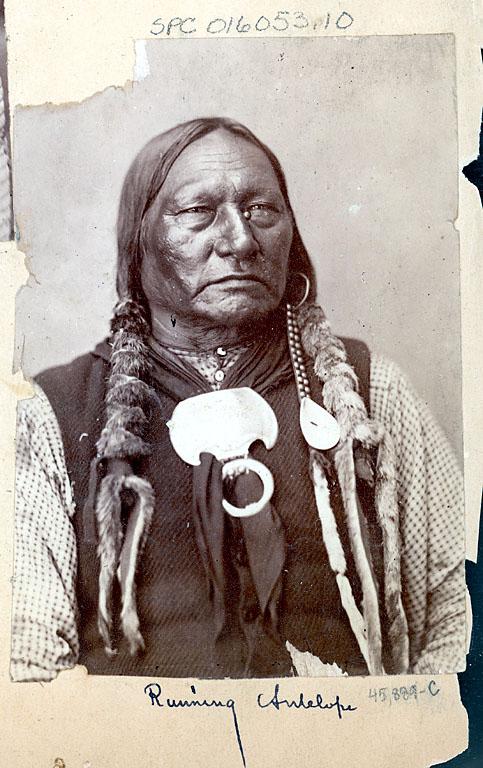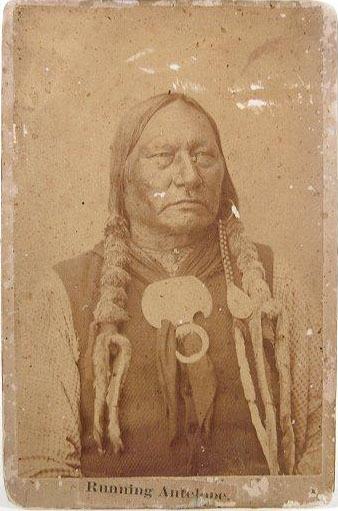
Photo
by Alexander Gardner in 1872
Running
Antelope was born ca. 1820, the son of a Hunkpapa father
and a Sihasapa (Blackfoot Sioux) mother. His paternal
grandfather was also named Running Antelope, but I don't
know his father's name. —
Kingsley Bray


From
eBay.com:

Outstanding
and very rare, original, ca 1880 Cabinet Card Photograph
of famed Oncpapa (pronounced Hunkpapa) Sioux Chief Ta-to-ka-in-yan-ka,
also known as Running Antelope by D.F. (David Francis)
Barry. This fantastic Cabinet Photo was fully titled by
Barry as simply “Running Antelope”. The photograph depicts
the middle aged Oncpapa Chief wearing his hair bound in
otter fur and with a large, highly decorative scarf slide
at his neck. The cabinet card measures approx. 4 1/4"
x 6 3/8" and carries the mark of the photographer
on the back which reads “D. F. Barry / Photographer”.
We believe that this back mark was used by Barry before
1883 when he returned to Bismarck, D.T. Known for his
bravery in war, and skills in oratory and diplomacy, Running
Antelope was one of four Hunkpapa principal chiefs who
acted as close advisors to Sitting Bull during the Plains
Indian Wars. His belief that compromise with the whites
was in their best interests led to his eventually distancing
himself from Sitting Bull. One of the only American Indians
depicted on U.S. paper money, the picture used for the
Series 1899 $5 Silver Certificate caused much ill will.
It pictured the Oncpapa Sioux Chief Running Antelope wearing
a Pawnee head dress as the original Sioux head dress was
too tall for the engraving.
This very rare and much sought after Cabinet Card photo
is in somewhat worn condition - the focus is sharp and
the image is strong but there is some overall darkening
to the albumen surface. There is some overall soiling
and a few small surface scuffs (see the scans below for
a good indication of the condition of this rare Cabinet
Card). The card mount is original with soiling and edge
wear. The back of the card has remnants of a scrapbook
/album page on which the Card was previously mounted.
A very rare and important Native American Indian Cabinet
Card Photograph and a fantastic addition to any collection!!!
When Running Antelope was born near the Grand River, presently
South Dakota, in 1821, few white men were in the area.
Consequently, he grew up in the old traditions of his
people. He learned to ride and hunt, and later went on
horse-stealing expeditions and war parties and joined
the secret societies. By the time he reached manhood things
had changed. The whites were more numerous, and the Indians
were forced to adapt to the new conditions. Many Sioux
took up arms and became strong in warfare; the Hunkpapas,
one of the smaller bands of the Tetons, became one of
the strongest. Running Antelope, however, was one of the
first Hunkpapas to reject the warpath and become a friend
of the whites. Running Antelope, in his earlier years,
was closely allied with Sitting Bull, who was eleven years
his junior. Running Antelope, a band chief, was prominent
among the Lakota. In 1851, Running Antelope was elected
one of four "shirt wearers" of the Hunkpapa.
A shirt wearer served to intercede between the council
and the headmen and akicita who carried out tribal policy
and decisions. He was a brave warrior and accomplished
diplomat. A great council with the Sioux was called at
Fort Laramie and Fort Rice in 1868. Running Antelope signed
the Treaty of 1868 at Fort Rice. It was often said that
Running Antelope was the greatest orator of the Sioux
Nation. He attended the Fort Laramie, Fort Rice and Fort
Peck treaty councils. Under the influence of James McLaughlin,
he became a dominant leader of the reservation Hunkpapa
people at the Grand River Agency. He was enrolled in 1868
at Grand River Agency, later part of Standing Rock reservation
in North and South Dakota. After the allotment period,
Running Antelope established a settlement of about sixty
families in the Grand River valley and opened a store.
In his later years, he regretted signing the 1868 Treaty
and longed for the time when the Lakota were free, and
realigned with Sitting Bull. Late in 1880, the followers
of Sitting Bull began to return from exile in Canada and
in the spring of 1881, Running Antelope was enlisted as
a scout in the army to go to Fort Buford to escort Gall
and his followers to Standing Rock. He was chosen to lead
the last great Sioux buffalo hunt in June, 1882. A large
herd was sighted about a hundred miles west of Fort Yates,
and a hunting party of 2,000 men, women and children left
the fort on June 10. The next morning the herd numbering
approximately 50,000 buffalo was sighted and the hunt
was on. About 2,000 were killed the first day, and the
camp moved up to the scene of the hunt and the butchering
began. The next day another 3,000 were killed and the
camp settled in near a creek to jerk the meat and prepare
pemmican. As usual when meat was plentiful, the labors
of the Indian camp were lightened by feasting. In 1899,
Running Antelope was pictured on the Five-Dollar Silver
Certificate. He died between June 30, 1896 and June 30,
1897. He is buried at the Long Hill Cemetery east of Little
Eagle, South Dakota. On the 1885 Standing Rock ration
list He had 10 lodges and 42 people in his care.
—
Comment by eBay Seller